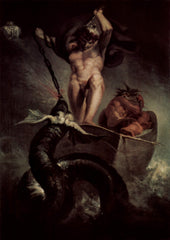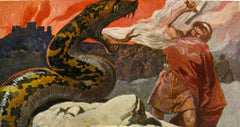on all orders over $100
on all orders over $100

The nine realms of Norse mythology were inhabited by a variety of weird and wonderful creatures. Whilst many were good in nature, many were also terrifying and vicious monsters so powerful that they posed a threat to the Gods themselves. One such creature was the giant serpent known as Jormungandr.
Also known as the 'Midgard serpent' or the 'World serpent' he was the son of Loki and the giantess Angrboda. His siblings were equally fearsome, being hel, the goddess of the underworld and Fenrir, the giant dire wolf.
Jormungandr was said to be so large that he encircled the seas of Midgard, which lead to the nickname 'the world serpent'. He would reside there, lying in wait, until the battle of Ragnarok where he would rise up from the depths to wreak havoc upon the Norse Gods.
Handmade Jormungandr Seax from VikingStyle
There was a particular connection between the fates of Thor, the god of thunder, and Jormungandr in the Norse sagas. The two of them would often do battle, and It was even prophesied that they would end up fighting to the death during Ragnarok.
In much the same way that Odin and the wolf Fenrir were bound together by their destinies in the prophecy so too were those of Jormungandr and Thor. This brings various questions for Norse scholars about the real of the nature of the terrifying but perhaps misunderstood beast.
In the Prose Edda it was stated that after his birth and whilst he was still small Odin decided to cast Jormungandr into the sea, hoping that he would die, in a similar way to which he decided to deal with Fenrir by binding him in chains. The creature did not die however and in the following years grew to a gigantic size in the ocean, much like his brother Fenrir did on land, and would eventually encircle Midgard.
The reasoning for these actions by the Gods against the young and relatively defenceless creatures was due to the fact that they knew that the prophecy foretold of their demise at the hands of these monsters. It is possible however that their own actions in an attempt to subvert the events of their own destiny actually turned the sons of Loki into the very monsters the Gods feared thus making the prophecy self fulfilling.
It is not surprising that a creature that was discarded and left to die at a young age such as Jomungandr, or one that was chained for its entire life like Fenrir, might become vicious and determined to seek revenge against the ones who had treated them so cruelly. Is it possible that Odin and Thor inadvertently set the events of Ragnarok into place by creating enemies out of these two beasts?

Silver Jormungandr Pendant from VikingStyle
The first meeting of Jormungandr and Thor was outlined in one saga from the Prose Edda where Thor traveled to Jotunheim with Loki and encountered a giant known as 'Utgard-Loki'. They began their travels with a human servant called Thjalfi. On their journey the group met a giant named Skrymir, who kindly made an offered to help carry their baggage for them. This turned out to be a trick, as the giant tied the the opening of the bag so tightly that no body was able to open it, not even the mighty god of thunder himself, meaning they had no access to their food.
In revenge for this Thor waited until the giant slept and then attacked him with Mjolnir, striking the giant three times on his head. Upon waking Skrymir asked if an acorn has fallen on his head and promptly left the group to continue on their travels.
A short while after the travellers arrived at a castle which was the home of Utgard-Loki. The party asked the giant to extend his hospitality to them, but he was not so welcoming and instead humiliated them for being so small and pathetic. He proposed to allow them to stay, but only if they proved their worth in a series of challenges.
The first challenge was to see who could eat the fastest, for which Loki volunteered. He managed to eat his way through the meat at an impressive pace, however his competitor Logi, also a giant, devoured all the food, bones and the trough in which it was served. Logi was pronounced the winner and they moved on to the next challenge.
The second challenge was taken up by Thjalfi, a human who was competing in a race around the court by Hugi. Being badly outmatched against a giant he had almost no chance of winning, and lost all three races in which he competed.
For the final challenge Thor engaged in a drinking contest where he had to empty a drinking horn. After a confident start he was unable to empty the horn and begrudgingly admitted failure. This amused Utgard-Loki who mocked Thor, however decided to allow him a chance to redeem himself. The giant challenged Thor to lift a small cat off the floor, surely he could do that. Despite his past humiliations and exerting all his strength the mighty god of thunder was not able to life more than a single paw of the cat from the ground. Bewildered and mocked once again by Utgard-Loki he accepted one final challenge; a wrestling match against an old woman named Elli. The two began to wrestle and the woman eventually forced him onto one knee, winning the match with relative ease.
Despite their failures in the challenges Utgard-Loki ultimately decided to allow the party to stay in his castle to rest. As they were leaving the castle the following day Utgard-Loki stopped them to explain their experiences in he challenges. The giant revealed that he was also Skyrmir, the one who had tricked them earlier on their journey, and that he had cast a spell upon them each time he had been stuck on the head with Mjolnir.
The spell caused the group to be deceived in all of their challenges. In the first challenge Loki's opponent 'Logi' was actually wildfire which had quickly burned through all the food, bones and the trough. Thjalfi's opponent Hugi was actually the fastest runner in the world, and when it came to Thors challenges the giant revealed that the horn from which he was dinking had its bottom in the sea, meaning no matter how much he consumer Thor would never be able to finish it. The saga states that despite his failure Thor managed to drink so much of the water that he actually lowered the sea levels noticeably and caused the tides to begin.
The cat which he had been challenged to lift in the penultimate challenge was actually Jormungandr, and Utgard-Loki expressed his admiration at the fact that Thor managed to lift the giant serpent as much as he did. In the final challenge the old woman with whom he wrestled was in fact old age, which no one had any chance of beating.
Upon hearing of the giants tricks Thor became angry and attempted to strike him with his hammer, however as he raised his arm the giant and the castle vanished into thin air, leaving the group standing alone.
This was believed the earliest recording of an encounter in the Norse sagas between Thor and Jormungandr, who would go on to meet numerous times before their eventual mutual destruction.
In one story from the Prose Edda Thor was on a fishing trip, accompanied by the giant Hymir. When the giant refused to supply Thor with bait the god was angered and rashly chopped the head of Hymir's largest Ox and used that instead. The two of them continued to argue for a good while before Thor demanded that they go further out into the open ocean in order to catch something bigger. Despite his protests Hymir eventually agreed.

Jormungandr being fished with an Ox head - 17th Century Icelandic Manuscript
Thor prepared his bait with a large hook and cast off into the ocean, before long there was a strong pull on the line, it was none other than Jormungandr. Pulling sharply upwards Thor wrenched the great serpent from the water and the two of them locked eyes. As Jormungandr stared menacingly at the pair of them, with blood dripping from his mouth, Thor reached for his trusty hammer, Mjolnir, in order to slay the beast. However Hymir, who was terrified, quickly cut the line and the serpent slithered back down to the depths of the ocean to encircle the earth once again.
In some earlier versions of the story, from the early Viking Age, Thor actually manages to successfully kill Jormungandr, however in Snorri's account this series of events only takes place during Ragnarok.
One of the early signs of the arrival of Ragnarok was said to be violent disturbance of the seas which would cause earthquakes throughout the nine realms. This would be caused by Jormungandr thrashing below the surface before he would eventually make his way onto the land. The earthquakes would break the chains that had been used to bind Fenrir and would also allow his father, Loki, to break free from his restraints.

Thor’s Battle with the Midgard Serpent - Johann Heinrich Füssli, 1788
The serpent would spray his poison all over the skies and seas and along with his brother, Fenrir, would join the forces of chaos from Muspelheim in their battle against the Aesir. In the final fight Loki will kill Heimdallr, Fenrir will devour Odin before being killed by one of his sons and Jormungandr and Thor will both fight to the death.

Thor and the Midgard Serpent - Emil Doepler
Jormungandr and Thor will fight hard, with Thor eventually coming out on top and managing to bludgeon the great serpent to death with Mjolnir, however he will have sustained too much damage and will die shortly after from the effects of the serpents deadly venom. In one final act of defiance against the gods who treats him and his kin so harshly Jormungandr will release so much venom into the cosmos that it will poison the air throughout the nine worlds and kill the majority of the remaining living creatures.
If you enjoyed our article or have anything to add please leave a comment below.
Check out our own design for the Jormungandr Viking Axe inspired by the Midgard Serpent.
Leave a comment